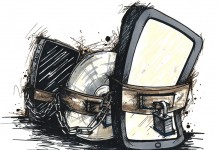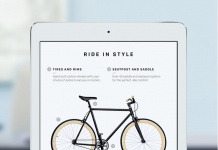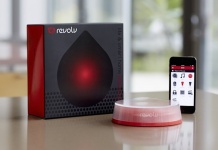 There is always a lot of discussion about which screen is better for reading ebooks: and LCD screen, which is often less expensive, or eInk-type screens, which are often more expensive. Interestingly, the arguments often revolve around eyestrain, but I’m not so sure that is the real separator.
There is always a lot of discussion about which screen is better for reading ebooks: and LCD screen, which is often less expensive, or eInk-type screens, which are often more expensive. Interestingly, the arguments often revolve around eyestrain, but I’m not so sure that is the real separator.
Today, editors rarely work on paper. We all almost always read and edit manuscripts on monitors. Some editors still cling to the older CRT (cathode ray tube) technology — I still remember trying to fit 3 CRT monitors on my desk — but nearly all have gone modern and use a LCD monitor. I can’t remember the last time I edited — or was asked to edit — a manuscript on paper. I do know that once I realized the value of editing on my computer, I turned down work that was paper based, and that was in 1985!
I work all day reading on my LCD monitors. I grant that at the end of the workday I am tired, but my eyes aren’t tired — well, no more tired than they would be had I spent the day reading paper or eInk. I don’t find LCD to be eyestraining.
But having said that, I still do not want to pick up a LCD ereading device. I find the eInk screen soothingly dull (and dull should be taken as a positive, not a negative attribute here). No matter how I view it, my LCD monitors do “push” at my eyes with their brightness and glare. True, I have adjusted the monitors so that the brightness and contrast are balanced for my eyes, but even so, there is still that stream of light that comes out of the monitor, aimed at my eyes.
Another problem with the LCD for reading ebooks is that its backlighting, while suitable for reading where there is no other light source, is unsuitable for reading in sunlight — it simply washes out. eInk lacks backlighting, just as a book lacks a lighting source, and so it does not wash out in sunlight. Consequently, with my eInk screen I can read while reclining in my hammock or when we go to the park or the pool, but I need a light source to read in bed.
But in the end, I’m not sure that which screen technology is used makes much of a difference, at least as far as eyestrain is concerned. Few people I know will spend 4 or 5 hours a day reading for pleasure; most spend an hour or 2 on their ereading devices. And how often does one have time to loll around the pool or enjoy the hammock (actually, I find the hammock so relaxing that I end up falling asleep rather than reading).
The real issue is what experience you want to mimic. It is the aesthetics that dominate, I think. I prefer the eInk screen because it is a closer mimic of the paper book reading experience, an experience I enjoy and want ebooks to emulate. I have a hard time thinking of ebooks as something other than another form of a pbook; I should really separate the two completely and develop an ebook-only perspective, but I think that is difficult for my generation or for any generation that grew up with pbooks. The newest generation will make that separation much more easily and naturally because it will have been weaned on ebooks.
Reading on a LCD screen reminds me of reading on a computer, which reminds me of work, not pleasure, reading. The eInk experience lets me separate work and pleasure reading cleanly, something that as a self-employed person I need to do: Isn’t that one of the drawbacks of being self-employed? The difficulty in stopping work? (I would add that the reminding me of my computer is one of the reasons I dislike Amazon’s Kindle. Its always-visible keyboard and its reliance on a scroll button is simply too close to my work experience; it doesn’t provide a clean escape.)
If you find that at the end of the workday you could continue reading on a LCD screen, then consider an ereading device with a LCD screen; they tend to be less expensive than their eInk counterparts. The only significant negative is the difference in how long a battery charge will last; an LCD’s battery life is generally measured in single-digit hours whereas an eInk device’s battery life is measured in weeks. At least for today, LCD offers the advantage of color; eInk is currently black and white, although color is in the future.
I, however, plan to continue investing in eInk. I expect my next device to be the forthcoming Sony PRS-950, which is due to be released in November. I want my ebook reading experience to mimic my pbook reading experience as much as possible.
Via Rich Adin’s An American Editor blog


































My eBookWise uses backlit technology, but it does not wash out even in direct sunlight (unlike my phone, for example, which is useless in sunlight). I don’t know what they did with these early readers, but they really were ahead of the times. By today’s standards, it’s a little heavy, and the pixel density isn’t perhaps quite that of the Kindle (my other reader), but it’s highly legible. As I said, I don’t know what eBookWise did that Apple or others don’t/can’t (perhaps it’s different on a black and white device). It is nice to be able to read in bed without turning on an external light, which is why the eBookWise will stay in use even as I do most of my reading on the Kindle.
Rob Preece
Publisher
Rich,
It seems to me that your complaint about LCD’s ‘pushing’ light at your eyes makes no sense.
This is a configuration issue. If you select a black background and green or yellow text (when available) or even white text, and turn down the brightness, the ‘pushing’ problem cannot be meaningful.
Regards, Don
Rich,
it’s “an LCD screen,” not “a LCD screen.”
SpellCheck wouldn’t catch that.
Pat
Potential buyers should note the difference between a traditional LCD screen (think of your laptop’s screen) and a non-backlit LCD screen (think of a wristwatch’s display). Non-backlit LCD’s, like those in the Jetbook and Aluratek Libre, appear to the reader to work much like e-ink displays (and paper pages, for that matter): you need an external light source, they do not wash out in sunlight, and their battery life is much longer since they do not “push” light out through the display panel. The battery life is typically much longer than a display with a traditional backlit LCD screen but somewhat shorter than e-ink displays. One advantage of non-backlit LCDs is the speed of page turns/refreshes and there is no flicker or ghosting.